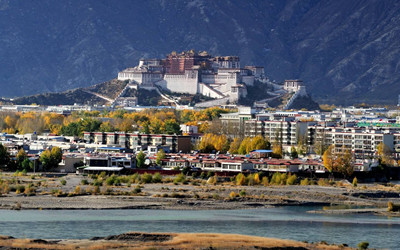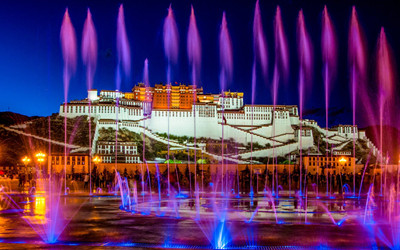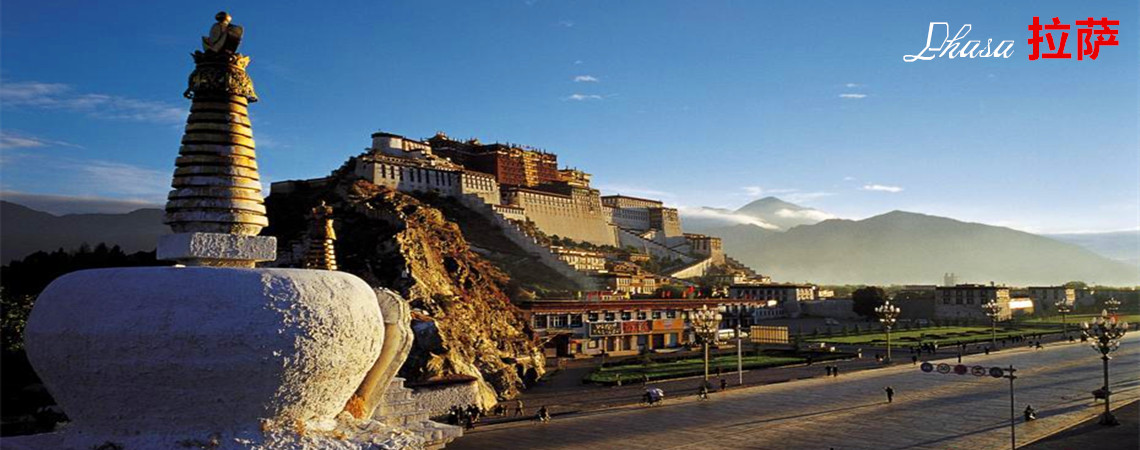- Home
- Top City Tours > Lhasa >
Lhasa Potala Palace
Lhasa Potala Palace, one of the most popular attractions in China, is now on the list of Chinese national key protected cultural relics, as well as the most valuable depot in Tibet. The palace is widely known for the countless precious sculptures, murals, scriptures, Buddha figures, murals, antiques, and religious jewelry housed in its many rooms, all of great cultural and artistic value, so it is a huge treasure house of ancient materials and articles of Tibetan history, religion, culture, and arts. In 1994, Potala Palace was declared a UNESCO World Cultural Heritage Site.
External Appearance And Structure
 Potala Palace is 3,756.5 meters above sea level, covering an area of over 360,000 square meters, measuring 360 meters from east to west, and stretching 270 meters from south to north. It has a total of 13 stories, and is 117 meters high. The walls of the palace are over 1 meter in thickness, with the thickest sections being 5 meters wide. Moreover, the walls are covered with huge, colorful, carefully painted murals, allowing history to seep back into the building beautifully and gracefully.The magnificent Potala Palace is made of sturdy wood and stone; all the walls are of granite, and all the roofs and windows are of wood. The overhanging eaves and upturned roof corners, not to mention the gilded brass tiles and gilded pillars inscribed with Buddhist scriptures, bottles, makara fish designs, and gold-winged birds decorating the roof ridges all contribute much to the beauty of the hip-and-gable roofs.
Potala Palace is 3,756.5 meters above sea level, covering an area of over 360,000 square meters, measuring 360 meters from east to west, and stretching 270 meters from south to north. It has a total of 13 stories, and is 117 meters high. The walls of the palace are over 1 meter in thickness, with the thickest sections being 5 meters wide. Moreover, the walls are covered with huge, colorful, carefully painted murals, allowing history to seep back into the building beautifully and gracefully.The magnificent Potala Palace is made of sturdy wood and stone; all the walls are of granite, and all the roofs and windows are of wood. The overhanging eaves and upturned roof corners, not to mention the gilded brass tiles and gilded pillars inscribed with Buddhist scriptures, bottles, makara fish designs, and gold-winged birds decorating the roof ridges all contribute much to the beauty of the hip-and-gable roofs.
This grand structure consists of over 1,000 rooms including seminaries, chanting hal1s, temples, chambers for worshipping Buddha, and chambers covered with gold 1eaf and studded with jewels housing the stupas of several Dalai Lamas. Throughout the rooms, there can be found tens of thousands of Buddha figures. Walking in, it is difficult not to be struck by the figures’ vibrancy, given off by their different sizes and complex designs.
History of Potala Palace
Potala Palace was built in the 7th century, meaning it has a long history of over 1,300 years. In 641, Songtsan Gambo, ruler of the Tubo Kingdom, had Potala Palace built for Wen Chen Konjo (Princess Wencheng) of the Tang Dynasty (618-907), whom he was soon to marry. This structure was later burned to the ground during a war. The hall for worshiping bodhisattva Avalokitesvara and the statues of Songtsan Gambo and Wencheng Konjo now on display are said being the only survivors from the war vandalism. Potala Palace was later rebuilt in the 17th century by the Fifth Dalai Lama (Ngawang Lobsang Gyatso). From then, repeated repairs and expansions until 1645 finally brought the palace to its present scale. Over the past 3 centuries, the palace gradually became a place where the Dalai Lamas lived and worked, as well as a space for keeping the remains of successive Dalai Lama.
 Potala Palace has also always been the political center of Tibet since the fifth Dalai Lama (1645-1693). In 1645, the Fifth Dalai Lama, feeling too confined at Drepung Monastery just outside Lhasa, ordered the construction of a new structure that would accommodate his new role as both a religious and political leader. This was what led Potala Palace to be built, as the imposing and self-confident expression of the new theocracy. With the ascension of the Seventh Dalai Lama (Kelzang Gyatso; 1728-1757), the Summer Palace was established at Norbulingka (a stunning garden just outside of Lhasa). Potala Palace then transitioned to be used predominantly during winter, earning its other name, "Winter Palace."
Potala Palace has also always been the political center of Tibet since the fifth Dalai Lama (1645-1693). In 1645, the Fifth Dalai Lama, feeling too confined at Drepung Monastery just outside Lhasa, ordered the construction of a new structure that would accommodate his new role as both a religious and political leader. This was what led Potala Palace to be built, as the imposing and self-confident expression of the new theocracy. With the ascension of the Seventh Dalai Lama (Kelzang Gyatso; 1728-1757), the Summer Palace was established at Norbulingka (a stunning garden just outside of Lhasa). Potala Palace then transitioned to be used predominantly during winter, earning its other name, "Winter Palace."
Potala Palace is famous for its grand buildings, complicated construction, devotional atmosphere, and splendid artworks, and the main attractions are the White Palace (administrative building) and the Red Palace (religious building). From the east entrance of the palace, a broad corridor painted with images of Four Heavenly Kings leads upwards to Deyang Shar courtyard, which is where Dalai Lamas used to watch operas. Around the large and open courtyard, there used to be a seminary and dormitories. West of the courtyard is where one may find the White Palace.
What to see?
The White Palace
The White Palace, comprising halls, temples, and courtyards, serves as the living quarters of the Dalai Lama and the political headquarter of Potala Palace. There are 3 ladder stairs reaching inside of it; the central one was reserved for only Dalai Lamas and central government magistrates dispatched to Tibet. In the first hallway, there are huge murals describing the construction of Potala Palace and Jokhang Temple, and the procession of Princess Wencheng reaching Tibet.
On the south wall, visitors will see a decree signed with the Great Fifth Dalai Lama's handprint. The West Chamber of Sunshine and the East Chamber of Sunshine lie as the roof of the White Palace. They belonged to the Thirteenth Dalai Lama and the Fourteenth Dalai Lama respectively. Beneath the East Chamber of Sunshine is the largest hall in the White Palace, where Dalai Lamas ascended throne and ruled Tibet.
The Red Palace
The Red Palace, with 7 golden roofs on its flat top, is renowned for its religious status, gorgeous stupas, and precious culture relics. The dominant buildings of the Red Palace are the stupa-tombs halls of Dalai Lamas and all kinds of halls for worshiping Buddha. It was constructed after the death of the Fifth Dalai Lama (1682). The center of the elaborate Red Palace is the Great West Hall, which records the Great Fifth Dalai Lama's life in its fine murals.
Enshrined and worshipped in the East Chapel is a 2 meter high statue of Tsong Khapa, the founder of Gelug which is Dalai Lama's lineage. The South Chapel is where a silver statue of Padmasambhava and 8 bronze statues of his reincarnations are preserved. On the floor above, there is a gallery which has a collection of 698 murals, portraying Buddhas, bodhisattvas, Dalai Lamas, and great adepts narrating jataka stories and significant Tibetan historic events.
West of the Great West Hall is the Thirteenth Dalai Lama's stupa hall. The North Chapel contains statues of Sakyamuni, Dalai Lamas, and Medicine Buddha, and stupas of the Eighth, Ninth, and Eleventh Dalai Lamas. In total, there are 8 stupa-tomb chapels where the relics of the Fifth, Seventh, Eighth, Ninth, Tenth, Eleventh, Twelfth, and the Thirteenth Dalai Lamas are preserved.
The Stupa Tombs
The stupa-tomb of the first Dalai Lama, known as a silver stupa, is situated in Tashilhunpo Monastery in Shigatse; and the silver stupa-tomb of Second, Third, and Fourth Dalai Lamas have been carefully placed in Dreprung Monastery in Lhasa. The stupa-tomb of the Eighth Dalai Lama is now in another palace which is also a part of Potala Palace. Among the 7 stupa-tombs in Potala Palace, that of the Fifth Dalai Lama, built in 1691, is known as the oldest and largest. Records say that it is made of sandalwood, wrapped in gold foil, and decorated with thousands of diamonds, pearls, agates, and others gems. The stupa, with a height of 14.86 meters, consists of more than 3,700 kilograms of gold.
Delicately designed, the intricate patterns on the stupa-tombs are truly amazing and striking. Mainly decorated with amber, pearl, coral, agate, diamond, and other precious stones, these designs add even more value to the whole stupa-tombs. Apart from the patterns, precious items housed in the stupas also make them priceless. There are a large number of cultural relics; for example, the stupa of Sakyamuni includes a thumb from his figure, a piece of a posthumous decree by King Songtsan Gambo, a portrait embroidered by Princess Wencheng, things left by previous high-ranking monks, and so on. According to Tibetan custom, the mummified and perfumed bodies of Dalai Lamas and Panchen Lamas are well kept in stupas, which is known as Stupa Funerals.
Around the stupa-tomb chapel of the Fifth Dalai Lama, there are also some chapels in which thousands of precious books and numerous scriptures written in Chinese, Manchu, and
Mongolian are carefully kept. In addition, there are many handwritten copies and printed books about history, medicine, culture, Buddhism and more. It is recorded that the total number of those books is over 200,000.
The stupa of the Thirteenth Dalai Lama (1876-1933) is housed in The hall of his stupa chapel is the hall . People started to build his stupa after his death in the fall of 1933, and as such, it is the most recent building in Potala Palace. Its construction took 3 years, and the stupa is comparable with that of the Great Fifth's; for example, it is 14 meters in height, which is only 0.86 meters lower than the Fifth Dalai Lama's. Made of a large amount of silver, covered with about 600 kilograms of gold, and studded with lots of coral, amber, agate, diamond, and other precious jewelries, the stupa is actually 10 times as valuable as that of the Fifth Dalai Lama's. In front of the stupa, there is a mandala made of more than 200,000 pearls and 40,000 other gems. Murals in the hall tell important events in his life, including his visit with Emperor Guangxu (11th emperor of the Qing Dynasty). The precious complete volumes of Kanjur have also been preserved in the chapel.
Travel Tips
Add: On the Moburi (Red) Mountain, the northern part of
Lhasa,
Tibet.
Transport: 1.By taxi from the back of the hill. 2.Climbing up from the front path.
Entrance Fee: CNY 100 yuan per person
Opening Hours: 9:30a.m-13:00p.m.;15:00p.m-18:00p.m
Notice:
1.More rooms are available in hotels on Monday, Wednesday and Friday.
2.Visiting the golden roofs costs an extra fee of RMB 10 yuan. Taking photos inside the room also charges extra fee, the prices are clearly shown in the rooms.

 Potala Palace is 3,756.5 meters above sea level, covering an area of over 360,000 square meters, measuring 360 meters from east to west, and stretching 270 meters from south to north. It has a total of 13 stories, and is 117 meters high. The walls of the palace are over 1 meter in thickness, with the thickest sections being 5 meters wide. Moreover, the walls are covered with huge, colorful, carefully painted murals, allowing history to seep back into the building beautifully and gracefully.The magnificent Potala Palace is made of sturdy wood and stone; all the walls are of granite, and all the roofs and windows are of wood. The overhanging eaves and upturned roof corners, not to mention the gilded brass tiles and gilded pillars inscribed with Buddhist scriptures, bottles, makara fish designs, and gold-winged birds decorating the roof ridges all contribute much to the beauty of the hip-and-gable roofs.
Potala Palace is 3,756.5 meters above sea level, covering an area of over 360,000 square meters, measuring 360 meters from east to west, and stretching 270 meters from south to north. It has a total of 13 stories, and is 117 meters high. The walls of the palace are over 1 meter in thickness, with the thickest sections being 5 meters wide. Moreover, the walls are covered with huge, colorful, carefully painted murals, allowing history to seep back into the building beautifully and gracefully.The magnificent Potala Palace is made of sturdy wood and stone; all the walls are of granite, and all the roofs and windows are of wood. The overhanging eaves and upturned roof corners, not to mention the gilded brass tiles and gilded pillars inscribed with Buddhist scriptures, bottles, makara fish designs, and gold-winged birds decorating the roof ridges all contribute much to the beauty of the hip-and-gable roofs. Potala Palace has also always been the political center of Tibet since the fifth Dalai Lama (1645-1693). In 1645, the Fifth Dalai Lama, feeling too confined at Drepung Monastery just outside Lhasa, ordered the construction of a new structure that would accommodate his new role as both a religious and political leader. This was what led Potala Palace to be built, as the imposing and self-confident expression of the new theocracy. With the ascension of the Seventh Dalai Lama (Kelzang Gyatso; 1728-1757), the Summer Palace was established at Norbulingka (a stunning garden just outside of Lhasa). Potala Palace then transitioned to be used predominantly during winter, earning its other name, "Winter Palace."
Potala Palace has also always been the political center of Tibet since the fifth Dalai Lama (1645-1693). In 1645, the Fifth Dalai Lama, feeling too confined at Drepung Monastery just outside Lhasa, ordered the construction of a new structure that would accommodate his new role as both a religious and political leader. This was what led Potala Palace to be built, as the imposing and self-confident expression of the new theocracy. With the ascension of the Seventh Dalai Lama (Kelzang Gyatso; 1728-1757), the Summer Palace was established at Norbulingka (a stunning garden just outside of Lhasa). Potala Palace then transitioned to be used predominantly during winter, earning its other name, "Winter Palace."





 Ask Questions ?
Ask Questions ?